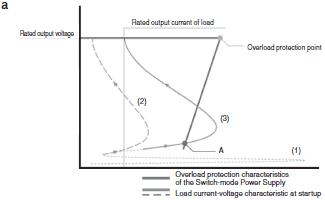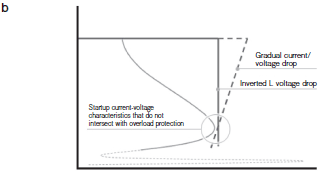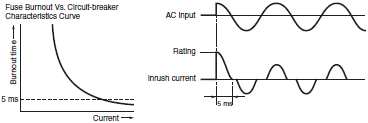Power Supplies
OMRON provides many types of general-purpose Power Supplies, such as the type mounted to DIN rail or the type built into equipment. OMRON also provides the S8VS which provides notification of replacement timing, and the Buffer Block that handles momentary power interruptions, and other highly reliable Power Supplies.
|
|
Features |
| Principles |
|
| Engineering Data | Further Information |
|
|
|
-
 Overload Protection Characteristics and Loads That Will Not Start
Overload Protection Characteristics and Loads That Will Not Start
-
 Internal Fuse
Internal Fuse
-
 Guideline for Selecting External Fuses and Breakers with Consideration for Inrush Currents
Guideline for Selecting External Fuses and Breakers with Consideration for Inrush Currents
-
 Power Supply Heat Generation
Power Supply Heat Generation
-
 Power Supply Life Expectancy and Life Expectancy Curve
Power Supply Life Expectancy and Life Expectancy Curve
-
 Wiring
Wiring
-
 Dielectric Strength Tests
Dielectric Strength Tests
-
 Maintenance
Maintenance
Overload Protection Characteristics and Loads That Will Not Start
If the rated load is connected or if a capacitive load with inrush current is connected, the output may be difficult to start or may not start.
Also, if the Power Supply is connected to a load with a built-in DC-DC converter, the Power Supply may not reach the rated output voltage even if a Power Supply with a rated output current that exceeds the load is connected.
When power is turned ON, a current of two to several tens of times higher than the rated current may flow, as shown by (1) in Figure a.
This is generally called the inrush current of the load, and is caused by charging capacitors in the electronic devices on the load side.
With a capacitive load, the inrush current is very large and it tends to flow for a long period of time, which means that time is required for the output to start.
If the load is a DC-DC converter and the Power Supply starts from a low voltage, the load current-voltage characteristics at startup will be as shown by (2) in Figure a. Two to several tens of times the rated current will flow before the current returns to the rated current.
The voltage at startup depends on the specifications of the DC-DC converter, but some will start as low as approx. 3 to 4 V.
If more than one load with these characteristics is connected, the startup current will attempt to exceed the vertical line of the overcurrent protection characteristics of the Switch-mode Power Supply (as shown by (3) in Figure a). The current and voltage will stabilize at point A in the figure, and the rated output voltage will not be achieved.
To prevent this, you need to select a Power Supply with a high enough capacity to supply the startup current, select a Power Supply with an inverted L voltage drop overcurrent protection characteristic that exceeds the startup current, or select a Power Supply with an gradual current/voltage drop for which the startup current-voltage characteristic of the DC-DC converter does not exceed the vertical drop characteristics of the overcurrent protection.


Internal Fuse
If the internal fuse has blown, it is very likely that internal circuits of the Power Supply have been damaged and that parts other than the fuse will also need to be replaced. If the fuse has blown, consult your OMRON representative.
Short-circuit current will not continue to flow on the primary side (i.e., the external side) of the Power Supply even if the fuse has blown. There is, however, no protection function for the input power lines.
Guideline for Selecting External Fuses and Breakers with Consideration for Inrush Currents
The inrush current pulse width can be considered to be about 5 ms. (See the following figure.)
In particular, models with 100-to-240 VAC input have higher inrush current energy than models with single rated inputs or models with switching inputs. Therefore, consider the coordination with the breaker.
The following table provides guidelines for fuse and breaker selection.
| Selection points | External fuses | Circuit breakers |
| Rated voltage | Sufficient for the input voltage of the Power Supply | |
| Rated current | Same as that of internal fuses * | Sufficient for the rated current of the Power Supply |
| Inrush current | Must not be burnt or tripped at the Power Supply inrush current (pulse width: approx. 5 ms). | |
| Fuse type | Normal burning or semi-time lag. | --- |

Note:The duration of the inrush current is 5 ms max. Therefore, the fusing characteristics require the inrush current to flow sufficiently for up to 5 ms.
*Refer to the block diagram in the datasheet for the current capacity of the Overload protection point internal fuse.
Power Supply Heat Generation
Use the following formula to find the amount of heat generated by the Power Supply (W).

The efficiency in the datasheets are for a load rate of 100%. Check the technical data for the actual values of each load rate.
[[Power Supply Life Expectancy and Life Expectancy Curve]]
The life of the Power Supply is determined by the life of the electrolytic capacitor that is used internally. The capacitor follows the Arrhenius law, i.e., the life is halved by every 10°C increase in temperature and double for every 10°C decrease in temperature.
The life of the Power Supply can thus be extended by lowering the internal temperature of the Power Supply.
Estimated Life Expectancy of Electrolytic Capacitors Using the Arrhenius Law (Major example)

The life expectancy for ambient temperatures and load rates can be found in the life expectancy Curve in the technical data.
Wiring
Wiring in Consideration of Voltage Drop
Make the input and output wiring as thick and short as possible to minimize voltage drop.

(1)Select a wire diameter suitable for the load current IO.
(2)Make sure that the Power Supply’s output voltage VO does not exceed the specified output fluctuation range.
(3)Consider the allowable current for load short-circuits (guideline: 1.6 times the Power Supply's rated output current or higher).
Selection of Wires
Select wires for the Power Supply carefully. Refer to this table when selecting the wires.
| AWG No. | Cross-sectional area (mm2) | Configuration (number of conductors/mm) | Voltage drop per 1 A (mV/meter) | Recommended maximum current (A) | |
| UL1007 (300 V 80°C) | UL1015 (600 V 105°C) | ||||
| 30 | 0.051 | 7/0.102 | 358 | 0.12 | --- |
| 28 | 0.081 | 7/0.127 | 222 | 0.15 | 0.2 |
| 26 | 0.129 | 7/0.16 | 140 | 0.35 | 0.5 |
| 24 | 0.205 | 11/0.16 | 88.9 | 0.7 | 1.0 |
| 22 | 0.326 | 17/0.16 | 57.5 | 1.4 | 2.0 |
| 20 | 0.517 | 26/0.16 | 37.6 | 2.8 | 4.0 |
| 18 | 0.823 | 43/0.16 | 22.8 | 4.2 | 6.0 |
| 16 | 1.309 | 54/0.18 | 14.9 | 5.6 | 8.0 |
| 14 | 2.081 | 41/0.26 | 9.5 | --- | 12.0 |
| 12 | 3.309 | 65/0.26 | 6.0 | --- | 22.0 |
| 10 | 5.262 | 104/0.26 | 3.8 | --- | 35.0 |
Recommended Maximum Current:
Current The table is applicable to wires with 1 to 4 conductors. Keep the Current value to within 80% of the values shown in this table when using wires having 5 or more conductors. The following chart shows the voltage drop per meter in terms of the relationship between the Current and conductor diameter. Make sure that the Current value does not exceed the recommended maximum Current value.
Wiring to Prevent Noise Interference
Separate input lines and output lines, and use twisted cables.
Noise will be induced on the output lines if they are laid together with or close to input lines.

Use short, thick input lines.
Input lines radiate noise, and must therefore be as short and thick as possible.

Do not loop input or output lines.
Loops in lines can radiate noise to other devices or can function as antennas inducing high-frequency noise.

Use short, thick ground wires.
The damping effect of the noise filter built into the Power Supply will be reduced if a long ground wire is used. Always make ground wires as short and as thick as possible.

Connect a noise filter.
Include a noise filter on the input side of the Power Supply if faulty operation in electric circuits connected to the output from the Power Supply are being caused by sources of surge on the AC input line, such as large magnetic relays.
Ground the noise filter with a thick, short wire.

Use shielded cables for the remote sensing and remote control signal lines.
Remote sensing and remote control signal lines must always be wired separately using shielded cables to prevent faulty operation caused by the induction of noise. Noise can be induced when these signal lines are laid together with input lines or power lines, which often carry noise.

Dielectric Strength Tests
When a high voltage is applied between the input terminals and case (FG), energy builds up through the inductor L and capacitor C of the internal noise filter.
When a high voltage of a dielectric strength test is applied to the Power Supply by a switch or timer, impulse voltage may generate and internal components may be damaged.
To prevent this impulse voltage, gradually change the applied voltage using the variable resistor on the dielectric strength testing equipment, or apply the voltage so that it crosses the zero point when it rises or falls.
Maintenance
Life Expectancy and Recommended Replacement Period
The life expectancies of OMRON Switch-mode Power Supplies are defined under the following conditions and are designed to be 8 or 10 years minimum.
Note:The life expectancy does not apply to the fan.
Rated input voltage
Load at 50%
Ambient operating temperature of 40°C
Standard mounting conditions
The replacement period and life expectancy are reference values only and do not imply a warranty of any kind. Use them as guidelines in designs and applications.
Fan Life and Replacement
Some Switch-mode Power Supplies have built-in fans for forced-air cooling.
The fans in these Switch-mode Power Supplies also have limited lives in addition to the lives of the Power Supplies themselves. The fans must be replaced periodically.
The replacement period for the fans varies with the Power Supply model. Refer to the datasheets for details.
Foreign Matter and Dust
There are slits in the Power Supplies that allow internally generated heat to escape to the exterior.
Foreign matter or dust can enter through these slits, causing the output to be reduced or to stop.
We recommend that you remove foreign matter and dust from around the Power Supply during periodic maintenance.



